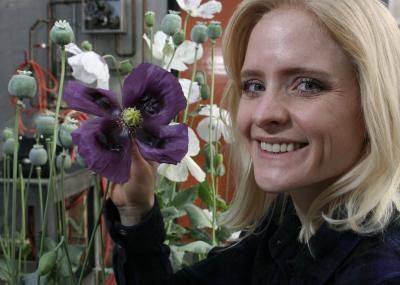St. John's wort: Important steps of biosynthesis discovered
This opens up the opportunity to obtain the complex ingredients biotechnologically
Advertisement
St. John's wort is one of the best-known medicinal plants. There are over 500 species worldwide. Its complex ingredients have promising medicinal properties. However, their isolation and synthesis are difficult. Scientists at the Institute of Pharmaceutical Biology at the Technical University of Braunschweig have identified two novel enzymes that form alternative molecular variants. This opens up the opportunity to obtain the complex ingredients using biotechnology. The results were published in the journal "Nature Communications".
St. John's wort extracts are used to treat mild to moderate depression. Their effectiveness has been proven in numerous clinical studies. The outstanding active ingredient is hyperforin. Over 1000 similar compounds have now been identified in other St. John's wort plants. What they all have in common is their complex chemical structure. This makes total synthesis, i.e. the complete chemical reconstruction of natural substances from basic substances, difficult.
Isolating the active ingredients is also challenging, as the content in the plants is low. On the other hand, the ingredients have many interesting pharmacological effects, such as antitumor (anti-cancer) and antibacterial activities. In order to develop an alternative source for their extraction, the Institute of Pharmaceutical Biology is endeavoring to transfer the biosynthesis from St. John's wort into microorganisms. Microorganisms are comparatively easy to cultivate in bioreactors as cell factories. The Center for Pharmaceutical Process Engineering (PVZ) at the TU Braunschweig is predestined for this process.
However, the reconstruction of plant biosynthesis in microorganisms requires the steps of the biosynthetic pathway to be known. This is precisely where a breakthrough has now been achieved. The ingredients of St. John's wort largely comprise two molecule variants that arise from the same precursor. A St. John's wort(Hypericum sampsonii) common in China is particularly rich in complex ingredients, and both molecular variants are represented. In 2010, Dr. Benye Liu brought this plant to the TU Braunschweig. Two new bifunctional enzymes have now been identified in this plant. They enlarge the precursor by one residue of five carbon atoms and also accomplish two positionally different ring bridges. This results in the two alternative, bridged molecular variants, which are decorated with side chains. The analysis of these enzymatic products and the complex ingredients was carried out in close cooperation with the Max Planck Institute for Chemical Ecology in Jena.
Another cooperation partner was an institute of the Chinese Academy of Sciences in Tianjin. Here, computer simulations were used to create models for both enzymes in order to explain their regiodivergent prenylative cyclizations - biochemical reactions in which a hydrocarbon (isoprene) is added to an open-chain side residue of the starting molecule, which then leads to the formation of a bicyclic (two-ringed) product molecule. These reactions are important in the biosynthesis of complex organic compounds and are inspiring for natural product chemistry as well as the biotechnological production of bioactive molecules.
Interestingly, the common precursor is bound upright in the first enzyme and the other way around in the second enzyme. The amino acids essential for the stabilization of these binding poses were identified and their mutual exchange transferred one enzyme into the other.
The bridged products of the enzymes studied here are probably the precursors for even more complex, cage-like compounds that also occur in St. John's wort and are of pharmaceutical interest. The search for the downstream enzymes that build up these even more complex compounds should be facilitated by the findings to date. This increases the chance of creating appropriate microbial production platforms to make the fascinating ingredients of St. John's wort available for preclinical development.
Note: This article has been translated using a computer system without human intervention. LUMITOS offers these automatic translations to present a wider range of current news. Since this article has been translated with automatic translation, it is possible that it contains errors in vocabulary, syntax or grammar. The original article in German can be found here.


























































